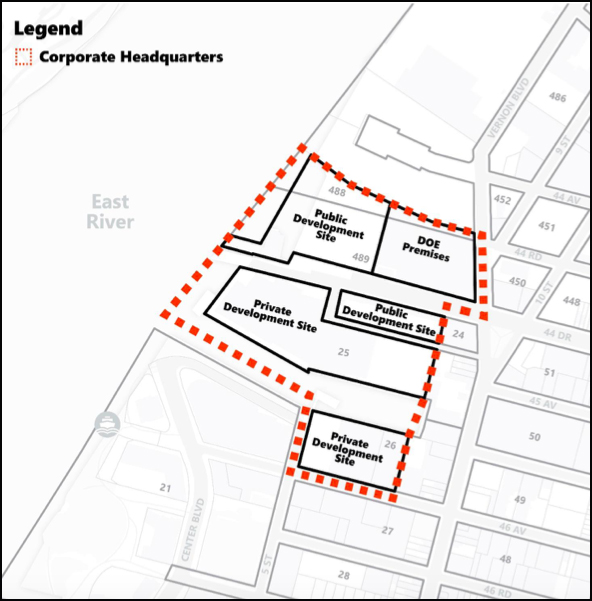The fine print of the sweetheart deal for Amazon to move one of its two new headquarters to Long Island City includes the creation of a minuscule "infrastructure fund" to benefit the already cramped subway and bus riders of Queens — but experts blasted the arrangement as too small and too beneficial to Amazon itself.
Amazon's contribution to the city and state will be $850,000 in annual rent on its new offices, plus "payments in lieu of taxes" that are supposed to be pegged at the prevailing property tax rate (though rarely are). Deputy Mayor Alicia Glen claimed the PILOTs would amount to $1.2 to $1.3 billion over the next 40 years.
At least half of those PILOT payments — roughly $600 million over four decades — will go for transit and other infrastructure improvements, the deal being inked today shows. The development site is on the Long Island City waterfront on land on either side of 44th Drive, about four blocks west of the Court Square E,G and 7 trains.
The state spun its PILOT deal and resulting fund as a positive.
"The Infrastructure Fund shall be used to pay for any infrastructure improvements (including but not limited to streets, sidewalks, utility relocations, environmental remediation, public open space, transportation, schools and signage) ... within a to-be-determined geographical area within Long Island City," the deal states.

The projects funded by the money in the lockbox will be recommended by "an Advisory Board to be appointed ... at such time that the Infrastructure Fund is sufficient to finance one or more capital projects."
And there's the problem, experts say.
"Amazon should be paying property taxes like everyone else, including Google, Facebook and the bodega owner down the street," said John Kaehny, executive director of Reinvent Albany. "But this deal allows Amazon to set aside half of its taxes to fund something the directly benefits Amazon and its employees. This is a massive subsidy and, worse, it's corporatism. It's letting the corporation decide where its tax dollars are spent."
Kaehny said the precedent would allow other payers of PILOTs, such as colleges, religious institutions and non-profits, to demand that part of their property tax payments be set aside for improvements that they want.
"What's next? NYU, Columbia, and the Catholic Church could demand that its money only goes towards cleaning its sidewalks," Kaehny added. "This deal also stinks from a public perspective. Google and Facebook didn't get this kind of deal and came to New York anyway, as Amazon would have.
"The name of this game is the governor landing this big fish so he can look good," Kaehny added.
Amazon should be required to build NYC three new subway lines as a condition for moving here and no they most certainly do not get to brand that shit the Bezos line or the Black Friday Deals line
— Travis R. Eby (@travis_robert) November 13, 2018
Nick Sifuentes of the Tri-State Transportation Campaign echoed Kaehny's contempt for the deal.
"[It] isn't going to make much of a dent in transit," Sifuentes said. "For starters, the dollar amounts will pale in comparison to the need — and the money doesn't even go to the MTA, instead going to EDC and the city. Ferry services might see a boost in subsidies, but the subways aren't going to see this have much of an impact at all."
Sifuentes saw a darker motive for Gov. Cuomo — creating a new stream of revenue for transit without having to do any hard work.
"The only way we're going to fix the transit services that matter is if the state funds Fast Forward," Sifuentes said, referring to NYC Transit President Andy Byford's $40 billion plan. "[This deal] lets Amazon avoid paying taxes and instead invest in improvements in their own development. ... Basically, riders would be better served if Amazon paid taxes like everyone else, rather than Amazon being able to funnel what would've been tax revenues into nicer sidewalks and ferry service for their employees to enjoy. That's not how we build and maintain a city. That's how we build a corporate city-state."
Typically, money from PILOTs goes into the city's general fund to be spent like other taxes.
Amazon said it would staff its new HQ2 with 50,000 people, though the company is now putting two smaller headquarters in Long Island City and Arlington, Vir., so staffing will likely be less than originally promised.
It is clear that the infrastructure fund won't be large enough to cover even a tiny part of the wish list put forward Tuesday by the Regional Plan Association, whose Vice President Dani Simons called for investment in "a few key projects" to "dramatically improve regional infrastructure."
A few?
"The BQX Streetcar would connect LIC to neighborhoods and housing opportunities along the Brooklyn and Queens waterfronts; a new commuter rail station at Sunnyside Yards would enable Long Island residents to take the LIRR; extending the Gateway Tunnel from Penn Station to Sunnyside Yards would provide a one-seat ride from New Jersey to Queens; and Penn Access would link the Bronx, Westchester and Connecticut with the neighborhood," Simons said.
It's unclear if any of those could be funded with a $15-million-per-year infrastructure fund, given that the deal requires the money is controlled by the Economic Development Corporation and must be spent "within a to-be-determined geographical area within Long Island City."
The deal also calls for New York State to "offer a package of project incentives ... including Excelsior tax credits and a capital grant."
So how sweet is the overall deal? In pitching it to Amazon, Empire State Development President and CEO Howard Zemsky promised, "Incentives structured on a post-performance basis that are valued at up to $1.705 billion, if the company creates as many as 40,000 jobs."
Amazon put out this press release.
Correction: An earlier version of this story wrongly valued the Amazon PILOT. It is $1.2 billion over 40 years.






